You are reading the older HTML site
Positive Feedback ISSUE
18
march/april 2005
Music,
Sound and Personalities: The 2005 CES and T.H.E. SHOW - page 2
by Dave
Glackin
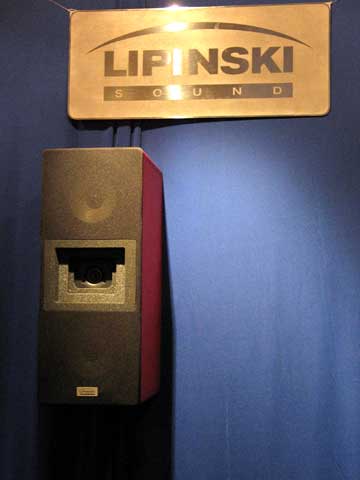
The Best Sounding Unlikely-Looking Speaker was being shown by Lukas Lipinski of Lipinski Sound, who very kindly gave us a demonstration after the show's official closing time, just as his crew was about to pull the plug on everything. The speakers were designed by Lukas' recording engineer father, for use as high-quality monitors in pro audio. But in the high end world, these d'Appolito-configured speakers had substantial hall-buzz at the show, and I was able to hear why. These speakers deserve more extended listening.
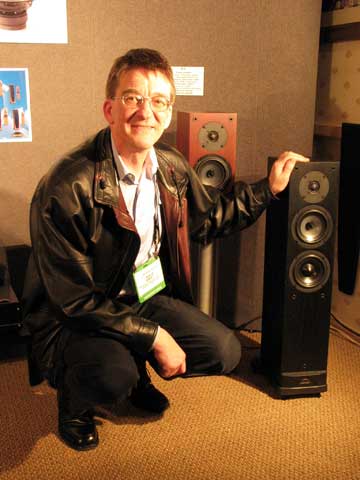
The Best All-Around Speaker at a Real-World Price is a very tough call, but one definite finalist is the Spendor S5e. Philip Swift, the director of Spendor (pictured), proudly demonstrated this speaker, and the reproduction of Cantate Domino was very nice indeed. Show conditions can be tough, but I was able to get a good idea of why this speaker has been receiving such rave reviews.
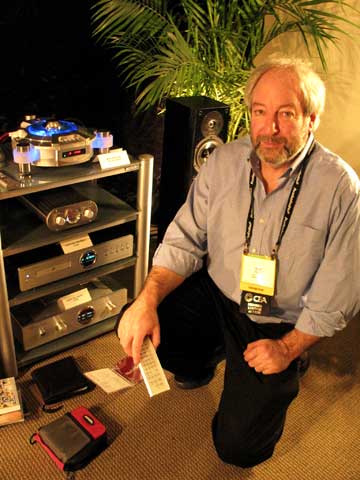
Choosing the Best Speaker at a Phenomenally Low Price is also a tough call, but at this show I think it was the Epos ELS3 imported by Roy Hall (pictured) of Music Hall. Quite a lot of speaker for $300. Roy also has my undying gratitude for informing me that my favorite single malt scotch, Lagavulin, was strongly rumored to be going out of production. Now, I don't want to scare anyone (heads up, David Robinson), but this is cause for action. Near as I can discern from my post-show investigation, it will be in limited production, but will keep going into the future. Time will tell.
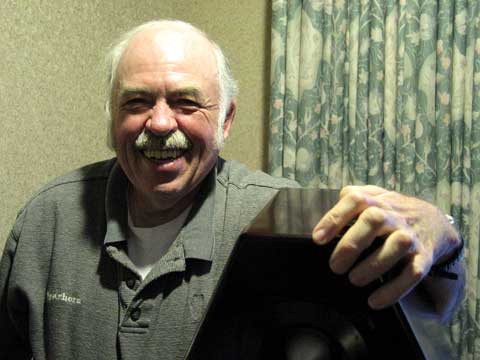
The Best Horn Loudspeakers were being shown by Dr. Bruce Edgar (pictured) of Edgarhorn. As loyal readers know, I think very, very highly of Bruce's work. But in the interest of full disclosure, Bruce used to work at the same federally funded R&D lab where I still do remote sensing and solar astronomy, and I did have input into very early versions of Bruce's speakers. But Bruce's present designs bear little resemblance to those efforts from almost two decades ago.
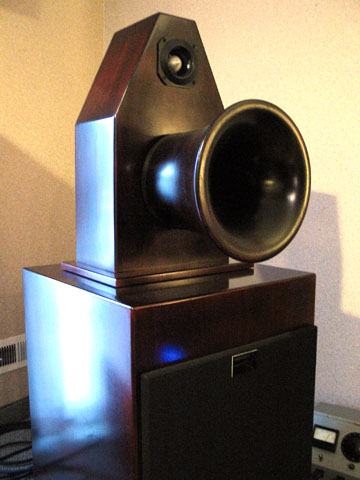
Pictured are the Edgarhorns. Not pictured are the refrigerator-sized horn-loaded subwoofers, of which Bruce produced 24 last year. Bruce's speakers were powered by electronics from Cy Brenneman of Cyrus Brenneman Audio. Cy makes some gorgeous looking and sounding tubed electronics that deserve your close attention.
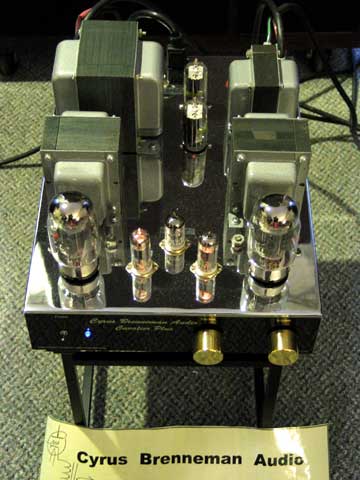
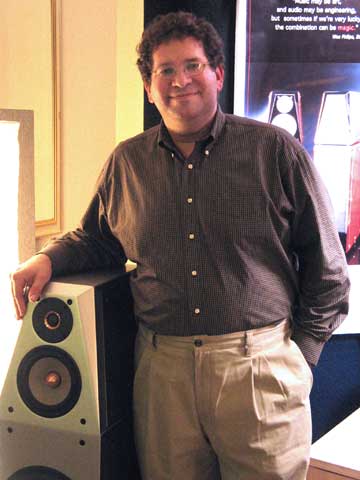
The Best In-Wall Speaker is very hard to judge in a show, but my pick was the Insider from Jeff Joseph of Joseph Audio. This $2K product reportedly has excellent dispersion because of the infinite-slope crossover. Jeff's RM-7 loudspeaker was also sounding quite excellent.
The Best Reborn Speaker was the ESP Concert Grand designed by Shawn McCaughan of Esoteric Audio Products. Shawn appeared out of the blue at last year's CES after an absence of 7 years, with a system that sounded open, transparent, and relaxed. Mike Veretto, now president of ESP, put on a demonstration that was getting a lot of hall buzz. Steve Hoffman co-hosted the demo, and he is using a pair of Concert Grands in his home now, as an extra set of ears to use in conjunction with his home mastering studio. The system sounded even better than last year, with some really amazing Nat King Cole and Miles Davis tracks. I was especially struck by the performance of these speakers far off-axis. This is definitely a design that does not require an optimized listening chair! The digital source was a one-box all-source player, designed by Alex Peychev of APL Hi-Fi. This was claimed to be competitive with the Meitner gear, for much less money. Now there's a subject for an in-depth review.
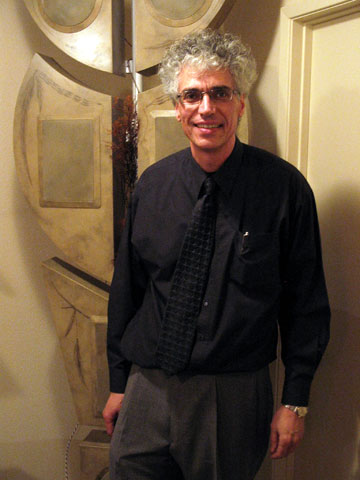
The Best Speaker Manufacturer Whose Speakers I Didn't Actually Get to Hear This Year was, in my opinion, Totem Acoustic. I caught Vince Bruzzese just after the show folded, alas, too late to hear a line of speakers that I have always held in high regard. Next year, Vince.
The Company with the Most Comprehensive In-House Capabilities was Audio Note. Upon sitting down in their room, I was regaled by Peter Qvortrup regarding the ins and outs of LP pressing, the RIAA curve, old LPs, old vs new mastering lathes, etc. Stan Ricker was in seventh heaven. This company makes its own turntable, amplifiers, and loudspeakers, and makes a surprisingly large number of their component parts in house, mostly using silver. They wind their own transformers. They make silver capacitors for the crossovers, with about 25 kg (or so my notes say) of silver in each crossover (!!). The crossovers were said to be heavier than their amps. Remarkably, Audio Note has built a silver-wired Westrex cutting head, and is working on 845-based silver-wired cutting amps. They make phono cartridges with a 5 µV output (lower than I have ever heard of), using wire with a thickness of 0.08 mm, and they make their own cantilevers. This is one serious company. We heard real music, beautifully reproduced.

The Most Gorgeous Amplifier was exhibited by The Hovland Company. Hovland has always stood out as one that is run by people with vision who really care, and it shows. Former professional architect Jeff Tonkin is responsible for the exterior appearance of their products, including the amplifier pictured.
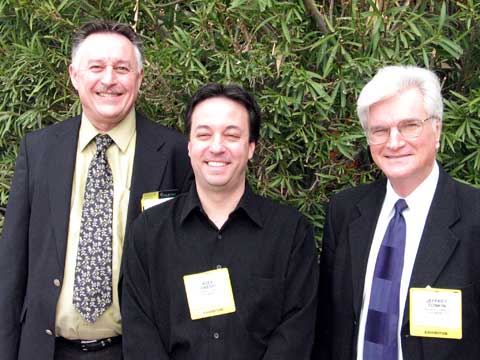
Jeff is on the right in this next photo with Mike Garges and Alex Crespi (center). Company founder Bob Hovland wisely decided to retain his sanity and stay home. It is always a true pleasure to see you guys at the show. Readers who do vinyl should know that Hovland's tonearm cables have been my reference for many years, and the Music Groove 2 remains firmly ensconced in my system. The system included a Dodson DAC and Avalon Eidolon Diamond loudspeakers, and sounded quite excellent.
The Best 845-based Amp in the show was from the deHavilland Electric Amplifier Company. (It was actually the Russian GM 70 in this amp, basically a Russian 845 with somewhat higher output). Designer Kara Chaffee and company president George Kielcyznski chose not to mess with last year's success, and used Nola (formerly Alon) Lotus Elite Signature loudspeakers, PranaWire from Joe Cohen, and the deHavilland Mercury preamp. Reel-to-reel tapes played on Kara's customized Ampex 351-2 were sounding very nice indeed.
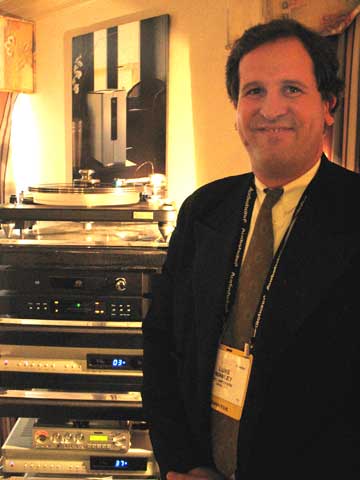
The Best Sounding Seriously High-Power Amps were being shown by Luke Manley (pictured) of VTL (Vacuum Tube Logic). VTL Deluxe 300s have been my reference for many years now. They are a marriage made in heaven with my big planar magnetostats. Luke was showing his latest creations: the 400 watt stereo S400 amplifier and the Siegfried monoblocks, with 800 watts per side. Also featured was the TL6.5 Signature Line Preamplifier, a one-box version of the two-box TL7.5; it retails for $5K. Very, very impressive products.
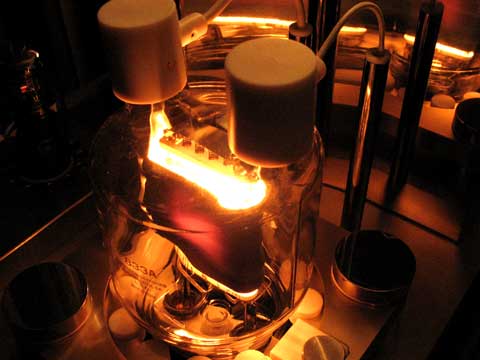
The Best Looking Tube was in the Wavac room. Jim Ricketts of tmh Audio was kind enough to remove the plexiglas cover from the Wavac HE-833, allowing me to get this close-up and once again ace out David Robinson in our attempt to capture the definitive photo of the 833A. ["Hah!!" sez Ye Olde Editor….] Maybe next year… maybe…
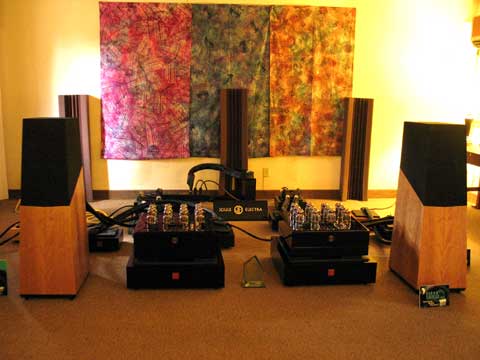
The Most Gorgeous OTL Amp was in the Joule Electra room. The big VZN-220 OTL monoblocks, sans company honcho Judd Barber, were sounding excellent through Vandersteen 5A speakers, especially after Stan had them turn up the bass a few wee tads. The amps were on custom stands by Critical Mass Systems, and cables were by Elrod Power Systems.
The Best US Debut of Japanese Amplifiers was in the Devore Fidelity/Shindo Laboratory room. John Devore was showing his Gibbon Super 8 loudspeakers, a very nice sounding high-efficiency two-way design. They were being powered by the gorgeous Shindo Monbrison tubed preamplifier and the Shindo Cortese F2A 10 watt pentode SE amplifier, as explained by Jonathan Halpern, Shindo's North American distributor. We heard truly gorgeous sound from two companies whose products were new to my ears.
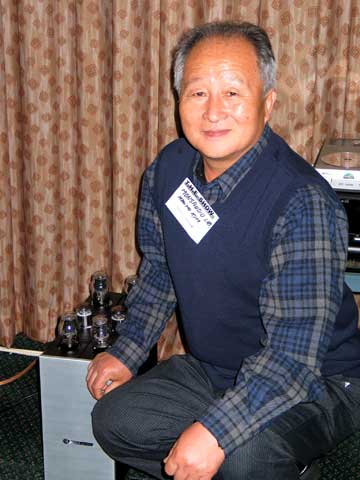
Man Ho Kim of Mons Audio was exhibiting a 2A3-based OTL-like amplifier, reportedly using an "autoformer" rather than a transformer. Man Ho (pictured) was exhibiting with Nucore loudspeakers, whose most notable feature was an extremely (and reportedly unprecedented) shallow crossover slope. The sound was quite good. Look for more from both of these companies.
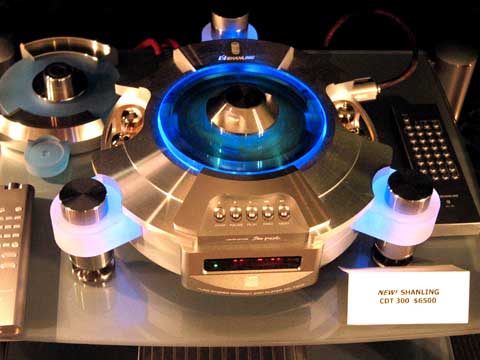
The Sexiest CD Player was being shown by Roy Hall of Music Hall. The photo of the new Shanling CDT 300 speaks for itself. If it's like my CDT 100, it will be HDCD capable and have 24/96 upsampling, not to mention TUBES.
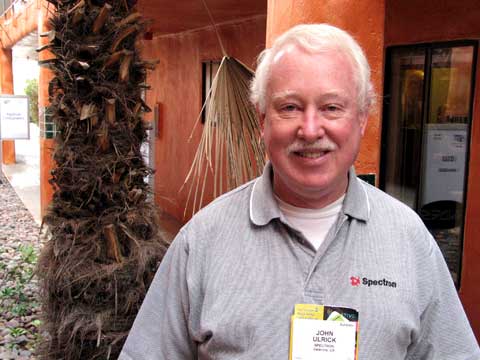
The Best Digital Vision of the Future was provided by John Ulrick (pictured) of Spectron. The Director, a product under development, will hold 20,000 cuts on a computer-controlled 200 GB hard drive, using a mirrored storage medium that can be removed for safety backup. I have known John for years, and have had thoroughly enjoyable and insightful conversations with him regarding the integrity of the audio press. I agree with and endorse his views strongly. Godspeed, John Ulrick.
The Best Executed Home Theater that I saw was being shown by Shane Rich of RBH Sound. The CinemaSITE (Signature In-wall Theater Environment) is an attractive large customizable unit using RBH speakers and a large screen. It was basically impossible to photograph properly, so check out rbhsound.com.
The Most Mysterious Tweak in the show was the Intelligent Chip from importer Allen Chang of Golden Sound. It was first introduced to me by Clark Johnsen (who is quicker on the draw with new tweaks than anyone in this field). Geoff Kait of Machina Dynamica provided much useful discussion, as he was exhibiting with Golden Sound. The chip is said to be based on the quite serious technology of quantum dots (called "artificial atoms" in some of their literature so as to not scare anyone off with the q word). I've seen this technology at Caltech's Jet Propulsion Lab via my real-life job, and it's quite real and not all that hard to understand if you have a background in physics or applied physics. But what it has to do with improving the sound of CDs and SACDs, I don't yet know, and I'm not entirely sure that anyone else does either. Like I said, mysterious. But Clark emphatically said that it does make a significant improvement, and that was good enough to move me to action. I look forward to trying these little orange devices in my system ASAP. (Remember Enid? People laughed at her at the time, and now the things she was saying have entered the common audio wisdom. What a difference a coupla decades can make.)
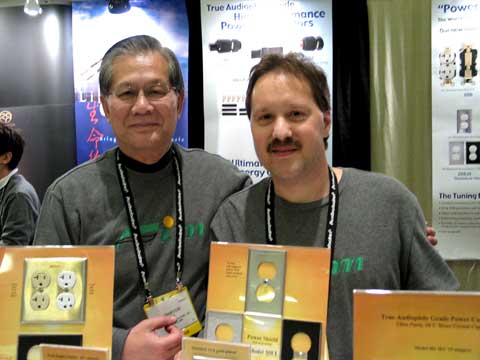
The Best Power Outlets to Ever Grace my System are from Winston Ma of First Impression Music (Winston is pictured here with Jerry Pomeroy.) If you think that power outlets can't make a big difference, think again. The FIM Model 880 Duplex Receptacle stands head-and-shoulders above Eagle or Hubbell outlets. In my reference system, definition of instruments, inner detail, and naturalness, as well as bass impact and definition were all markedly improved. These have been my new reference for the past year. I was startled by the level of improvement that resulted from the mere change of two AC outlets. This just proves the old adage that everything makes a difference, and these can make a very significant difference indeed. Very, very highly recommended.
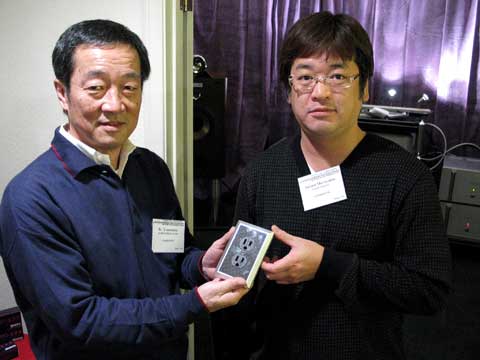
The Most Promising Power Outlets I've not Heard were being shown by Be' Yamamura of Acrolink and Satoru Murayama of Oyaide Elec, Inc. The Japanese are apparently crazy about their power outlets. Oyaide makes three versions; one 24-karat gold plated, which was said to sound "luxurious," one plated with silver and rhodium, which was said to sound "clean and tight," and was Be' Yamamura's favorite, and one plated with silver and palladium. What really caught my eye was the carbon fiber front plate, said to reduce RFI. I have one in hand for audition.
The Best Power Conditioner for Digital I've Auditioned is the Power Wing from Alan Kafton of audioexcellenceaz. I tried Alan's Power Wing about a year ago, and found it, in my system, to be especially effective on the digital side. At the time I suggested to Alan that I'd love to have a single-outlet version that I could plug my one-box CD player into. At CES, Alan said that he took that suggestion to heart, and is producing the Solo. I can't wait to hear it.
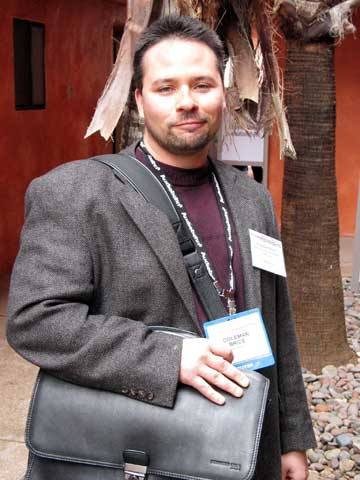
The Best Discussion of the Music Biz was with Colie Brice (pictured) of Mobile Fidelity. Talk about someone I would like to see do really well in this field. It's a distinct pleasure to know you, Colie, and very best wishes for the future.
The Best Discussion of Physics was held with John Curl. We got into a little bit of audio and a lot of cosmology, including the relatively new concept of dark energy, which boggles the minds of most astronomers. Many thanks to Clark Johnsen for introducing me to John.
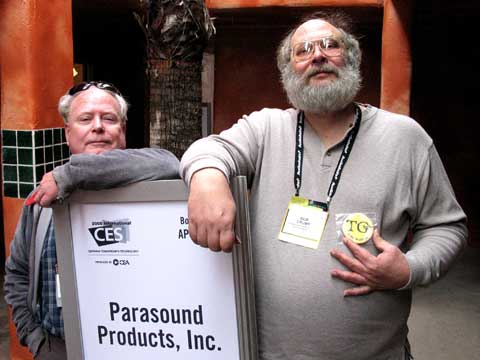
The Best Cookies were provided by Bob Crump of TG Audio/CTC Builders. Bob is the person responsible for bringing Misty River to CES and THE Show last year and enriching all of our lives. In this photo, Bob proudly exhibits his TG Audio cookie, while a hungry Stan Ricker ponders his options. CTC Builders (for Curl, Thompson & Crump) will be releasing two preamps designed by John Curl that "should be comparable to the Vendetta he did years ago," according to Bob. Now that's a news flash. (Release is intended for 2006.)
The Best Beer was uncovered at the Monte Carlo brewpub, thanks to the indefatigable Clark Johnsen. If you're in search of good beer, chances are that Clark knows just the place.
The Best Scotch was served by D.J. Casser of Black Diamond Racing. And served. And served. What a stand up guy! (Except that after a awhile, it took a bit of effort to do that.) No photos were available at press time.
The Best hor d'euvres were the Cast Iron Skillet Dumplings at the Z Tejas Grill. General Manager Schuyler Marks-Paulson runs an outstanding restaurant. Now about that sound system…
The Best Guy to See the Show With was, of course, Stan Ricker, who is not only a world renowned record mastering engineer, but is also one phenomenal conductor, musician, and teacher. My interview with Stan, which originally spanned 45 pages across three issues of the old hard-copy Positive Feedback Magazine, can be found reprinted in Positive Feedback Online (www.positive-feedback.com/Issue1/ricker1.htm). Even at this length, it only begins to plumb the depths of Stan's knowledge, wisdom, practical experience, and humor. Read it and learn from the master. Walking around the show with such a heat-seeking missile for good sound made my job one heck of a lot easier. And an absolute blast to boot!
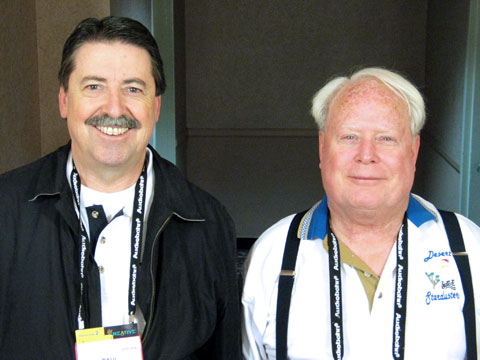
Who was the Best Mastering Engineer at the show? I think it was Stan Ricker, but maybe Stan thinks it's Paul Stubblebine. Either way, I caught these two buddies in the hall as pictured, talking up a storm. I'll let them decide.

The Best Happy Hour was put on by Positive Feedback Online. This was a great chance for me to meet more of the new writers who came onboard PFO during our merger with audioMusings.
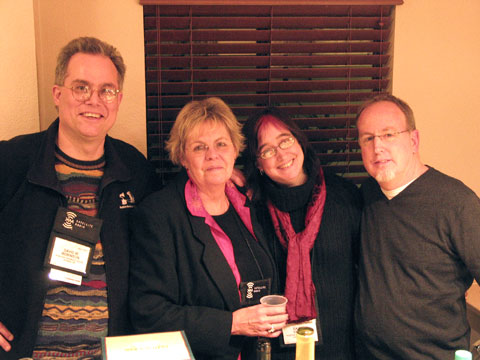
David Robinson and Lila Ritsema, and Carol and Dave Clark, together comprising the four-pronged punch (pictured) behind PFO, were caught in a rare moment without the single malt and cigars. Come to think of it, where were you hiding the Lagavulin this year, David?
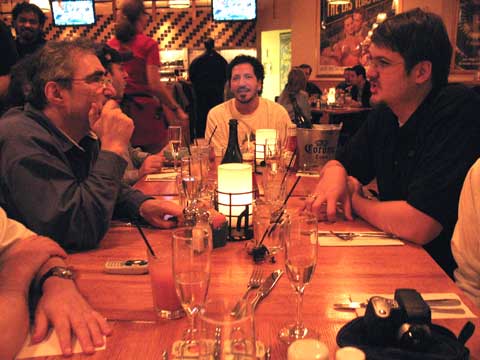
The Best Breakfast was enjoyed courtesy of Steve Rochlin of EnjoyTheMusic.com. Steve (pictured), minus bunny slippers and Ferrari smoking jacket, treated us all to breakfast at the Hard Rock Café once again. This was another great opportunity to talk to fellow writers whom I only see once a year. But Steve, you've gotta get yourself to the Monterey Classic Car Weekend this year, man! You'll love it. Driving a Ferrari around New Hampshire just ain't enough.
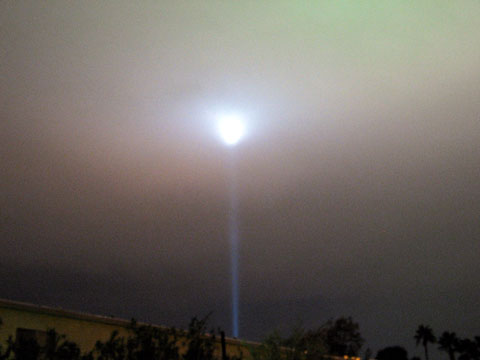
Finally, here is the Luxor searchlight, trying in vain to penetrate the rumors and locate the site of next year's CES high end show. Wherever it is, Mike Maloney will be back with T.H.E. Show right at the good old St. Tropez, or as Stan says, the "Saint Tro-paz."
An Old Friend Who Will Be Most Missed is Toy Shigekawa, who sadly passed away not long before CES. This man, whom I have often called "The Most Understated Physical Chemist" in the show, was renowned for his Torumat record cleaning fluid, CD treatment spray, and contact oxidizing inhibitor, not to mention his turntable mats and record dampers. Toy was a gentleman in every sense of the word. The community, and most definitely this writer, mourns his passing.
This year's report is dedicated to the memory of Toy Shigekawa.
